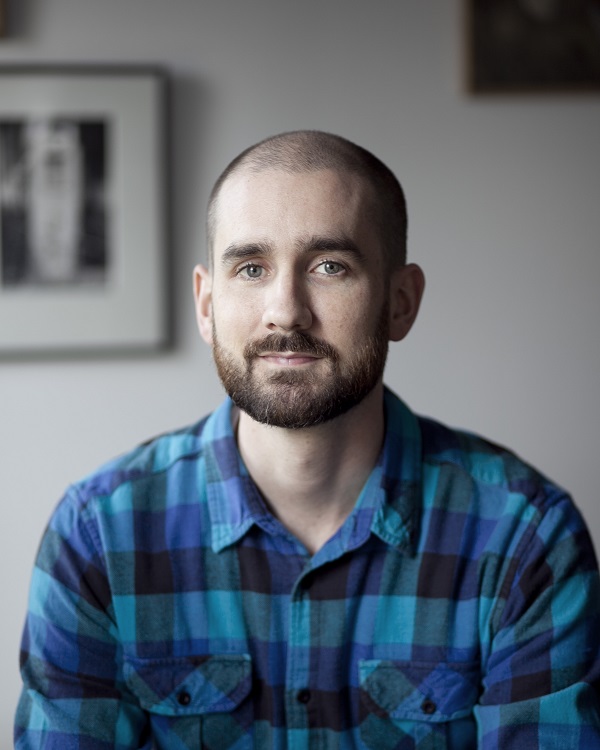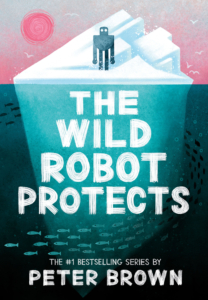
A Q&A interview with Peter Brown
 Roz, star of Peter Brown’s Wild Robot series is a Books for Keeps favourite. These thought-provoking stories of a robot who finds a family among the creatures on a remote island, uninhabited by humans, are full of humour and insight, and beautifully illustrated to boot.
Roz, star of Peter Brown’s Wild Robot series is a Books for Keeps favourite. These thought-provoking stories of a robot who finds a family among the creatures on a remote island, uninhabited by humans, are full of humour and insight, and beautifully illustrated to boot.
We put these questions to Peter on publication of the third book in the series, The Wild Robot Protects.
You’ve said you didn’t expect to write another Wild Robot story. What drew you back?
The second book in this series, The Wild Robot Escapes, has a very satisfying ending, and for a while I thought I might just end Roz’s story there. But I couldn’t stop thinking about Roz and Brightbill and their friends. I kept wondering what their lives would be like after the end of the second book. I imagined Roz marching around the island, solving little problems, and making everyone’s life a little better. But then I started imagining bigger problems that might come to the island. It was those big, existential problems that really captured my interest, so I decided to dive back into Roz’s world and I came up with The Wild Robot Protects.
What led you to decide that in this book, Roz has to defend her island home?
I’ve realized that the Wild Robot stories are all about home. In The Wild Robot, Roz makes herself a home on the island. In The Wild Robot Escapes, Roz tries to get back to her home. And in The Wild Robot Protects, Roz must protect her home island from a mysterious form of pollution that the animals call the poison tide. Roz has always been a protector. Throughout the first two books there are many scenes where she protects animals or people or places. But I wanted to further explore that side of her, and to imagine how she would grapple with a threat to the entire ocean.
In this new story, robot Roz has new abilities – has your understanding of her as a character changed over the course of the books?
The ways in which Roz changes, externally and internally, are central to her story, from the little scrapes and dents that appear on her body over time, to the way the wilderness changes her outlook on life, to how she uses prosthetic body parts made from natural materials, to developing a sense of responsibility toward her home island. At the end of The Wild Robot Escapes, Roz changes in a big way, when her mind is transferred to a new body that is tougher and stronger than her original body. Now, in the new book, Roz gradually gets to know her new body, and she discovers that it has some surprising abilities. It’s thrilling to write a character who can change in such profound ways.
In difficult or demanding situations, Roz has always looked for peaceful solutions. In this story, she discovers she can indeed fight when necessary. Why did you make this decision?
Roz’s peaceful nature is the thing I love most about her. In the first two books, she has no choice but to be peaceful because that’s how she’s programmed. This forces her to think creatively to find peaceful solutions to every problem. But, if given a choice, I think Roz would still choose to be peaceful. In many ways, violence and aggression are an easy way out of difficult situations. Choosing to be peaceful is a lot harder. It requires discipline and bravery and sacrifice. So, I decided to give Roz that choice. When she’s attacked by a dangerous sea creature, she discovers that her new body is capable of fighting. However, Roz is convinced that every problem really does have a peaceful solution. Despite her new fighting ability, she chooses to continue living as a peaceful robot, and her choice reveals the true quality of her character.
The book describes the effect of a ‘poison tide’ on animals and wildlife. We learn that humans are responsible, yet you are careful to make readers sympathetic to the workers on the mining rig. How important was that to you and why?
In real life, there are almost no true ‘bad guys.’ People who we might think of as ‘bad’ are usually just ignorant or desperate, in some way. I’ve always wanted the Wild Robot stories to feel as true to life as possible, and so I decided not to include any villains. Throughout these books, we encounter many characters who seem ‘bad’ at first. But as we learn more about them our feelings start to change. That’s how I wrote the human characters in The Wild Robot Protects, too. The more we learn about them, the more we realize that they’re doing their best in difficult circumstances, which is awfully relatable. The result of my writing decisions, hopefully, is that readers feel a greater connection to the characters and to the story.
You’ve said that you first had the idea for a book about a robot when working on The Curious Garden, which was published in 2009. Do you think our attitude to robots has changed in that time?
Absolutely. In 2009, the only robots most people thought about were those in science-fiction movies. Nowadays, artificial intelligence and robotics are becoming an increasingly visible part of our everyday lives. Honestly, I don’t think most people are ready for the technological revolution that’s coming. But it doesn’t have to be scary. I’m not worried about the kind of robot uprising that we see in so many movies. I think robots will disrupt how we currently live our lives, but I think they’ll end up doing enormous good in the world.
Roz faces lots of dangers in the book. Did you ever consider an ending in which she doesn’t come home?
Yes, and I play with this idea at the end of The Wild Robot Protects when Roz disappears from the story and we’re not sure what’s happened to her. I can think of a number of scenarios where Roz would have to leave her home island, forever. Who knows, maybe I’ll write one of those stories, eventually. But for this story, I thought it made sense to handle things a little differently.
The illustrations in the book are wonderful (again). Do you have a favourite image? If so, which one and why?
I had a lot of fun illustrating the title page, in which we see an underwater scene of a kelp forest. For it to really feel like we’re underwater I had to get the sense of depth and lighting just right. So, the fish and the kelp stalks get lighter as they fade into the murky distance. And I added a subtle glow to the upper area and a few bright streaks shining through the foliage, to give the effect of sunlight filtering down from the surface. My art is quite simple and graphic, but I think I was able to capture the feel of a kelp forest at midday.
It’s just been announced that Dreamworks will adapt The Wild Robot as an animated film. Can you tell us more about this?
Dreamworks optioned the film rights to The Wild Robot before the book had even been published, so this has been in the works for quite a while. Over the last couple of years, I’ve had many conversations with the director and the producer. They’ve shared concept art and storyboards with me, and we’ve had lengthy conversations about the characters and the dialogue and the arc of the story. I won’t lie, The Wild Robot means a great deal to me, and it wasn’t easy handing it over to someone else, but I couldn’t have asked for a better team. Dreamworks is one of the very best animation studios in the world. The director, Chris Sanders, has a long, impressive career in feature animation, starting back when he worked on the Disney movies of the 1980’s and 1990’s. He went on to direct Lilo & Stitch and the How To Train Your Dragon movies, among others. I’m really excited to see what Chris and his team come up with.
Might Roz have more adventures?
She might! It’s too soon to say what’s next for Roz, but you haven’t seen the last of her.
The Wild Robot, The Wild Robot Escapes and The Wild Robot Protects are published in the UK by Piccadilly Press, paperback £7.99 pbk.





